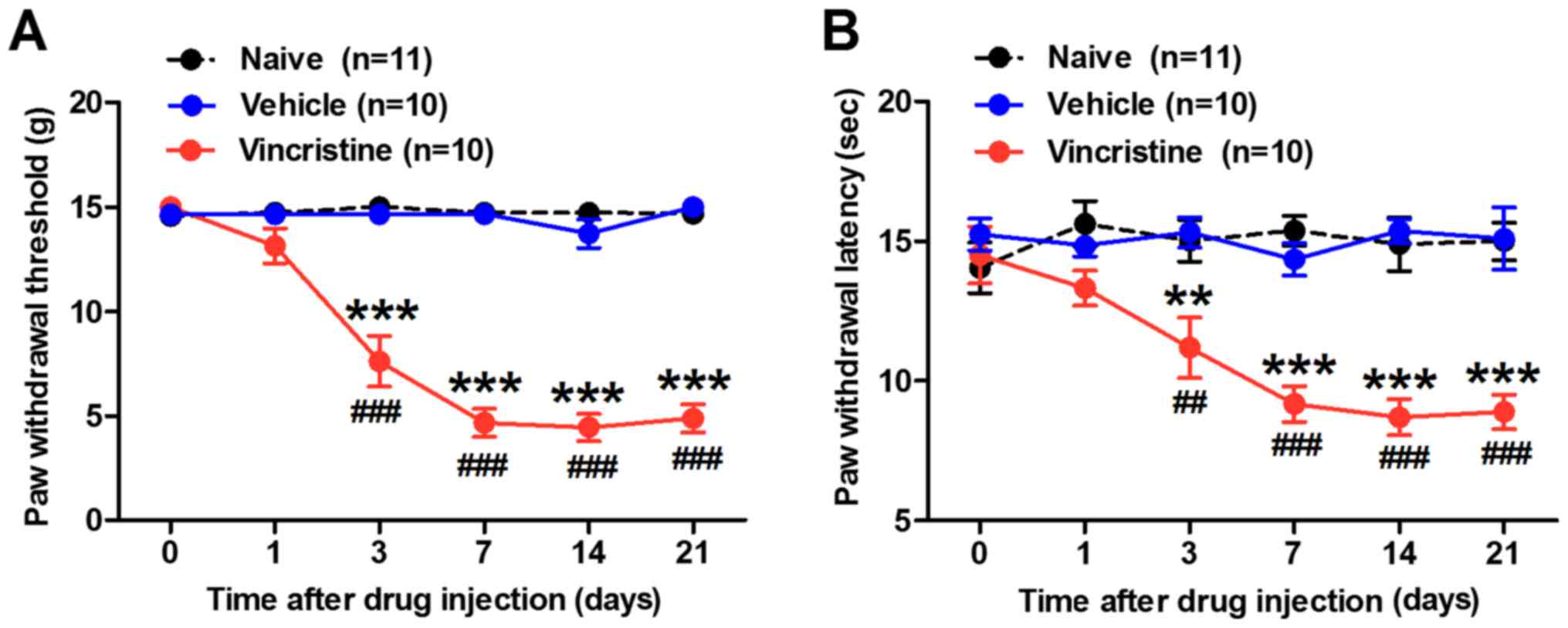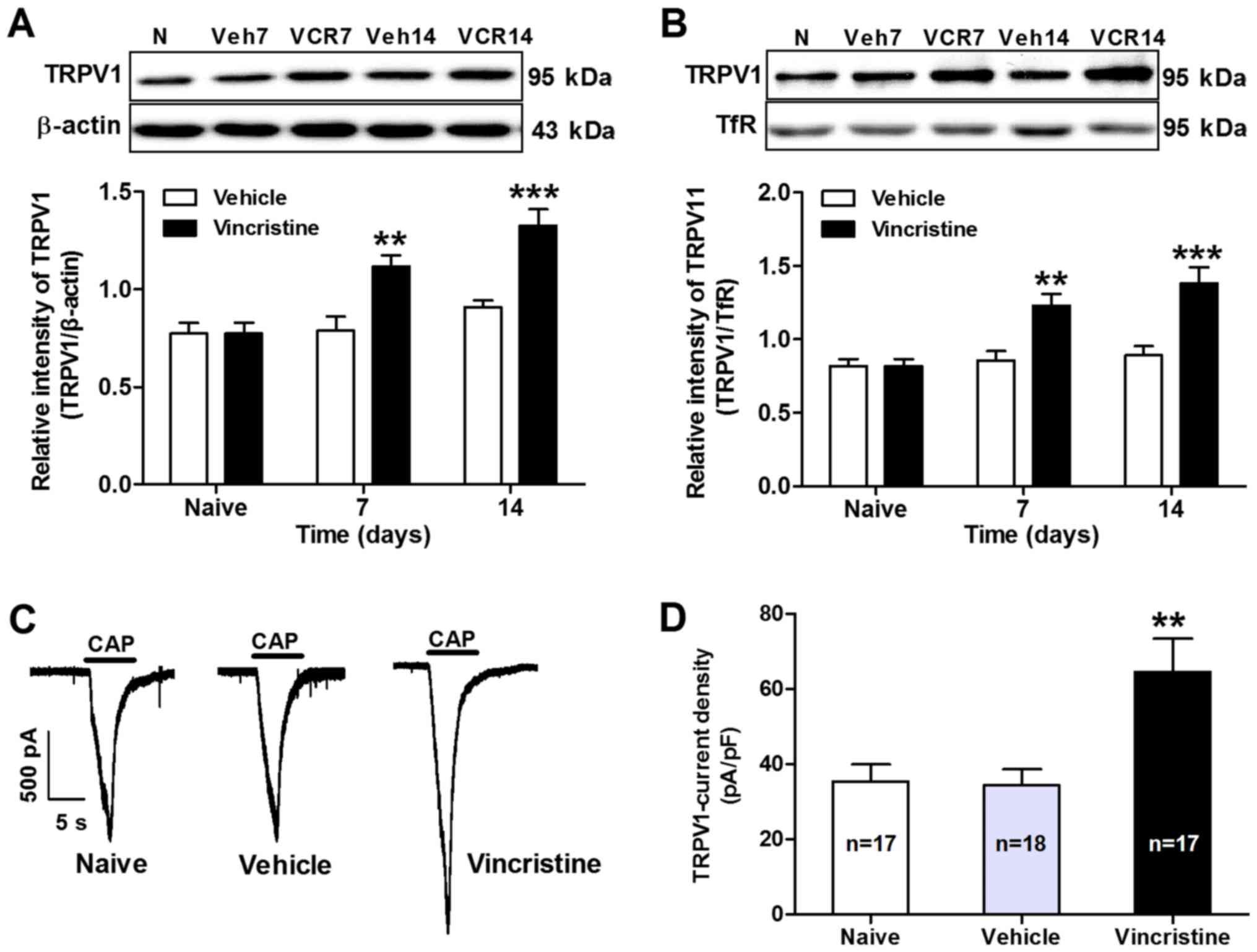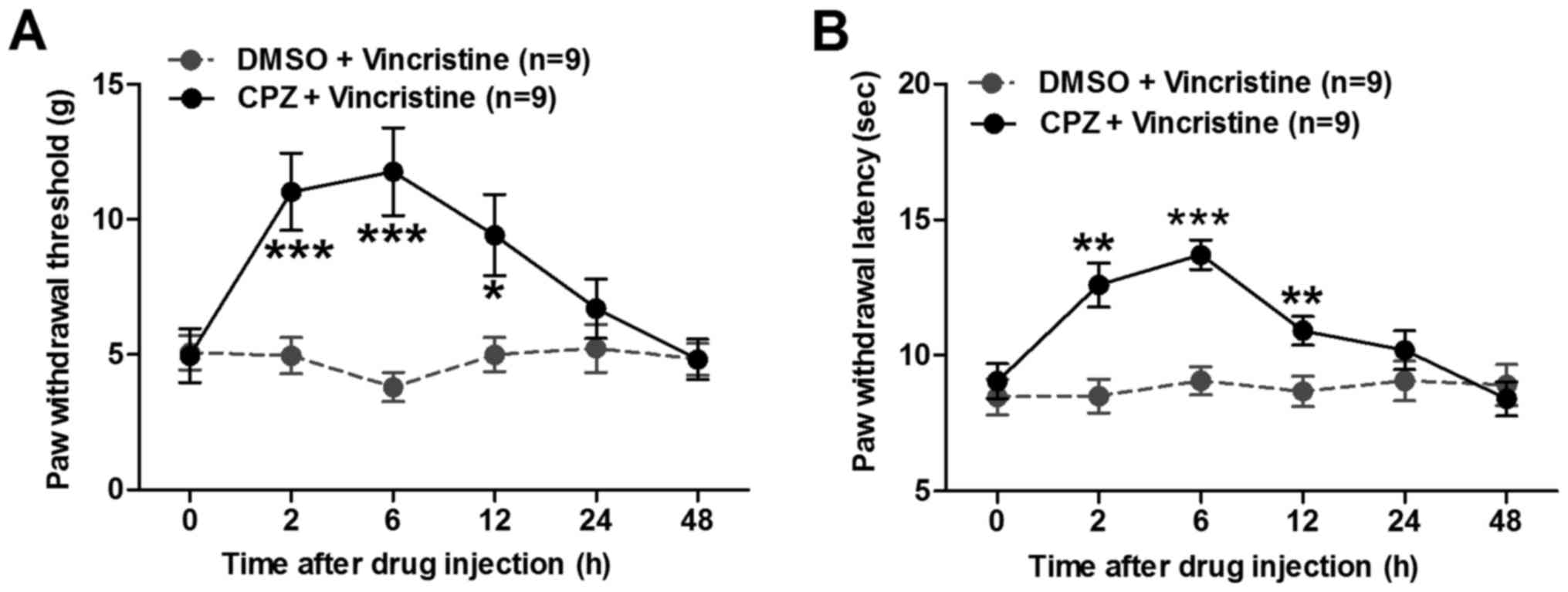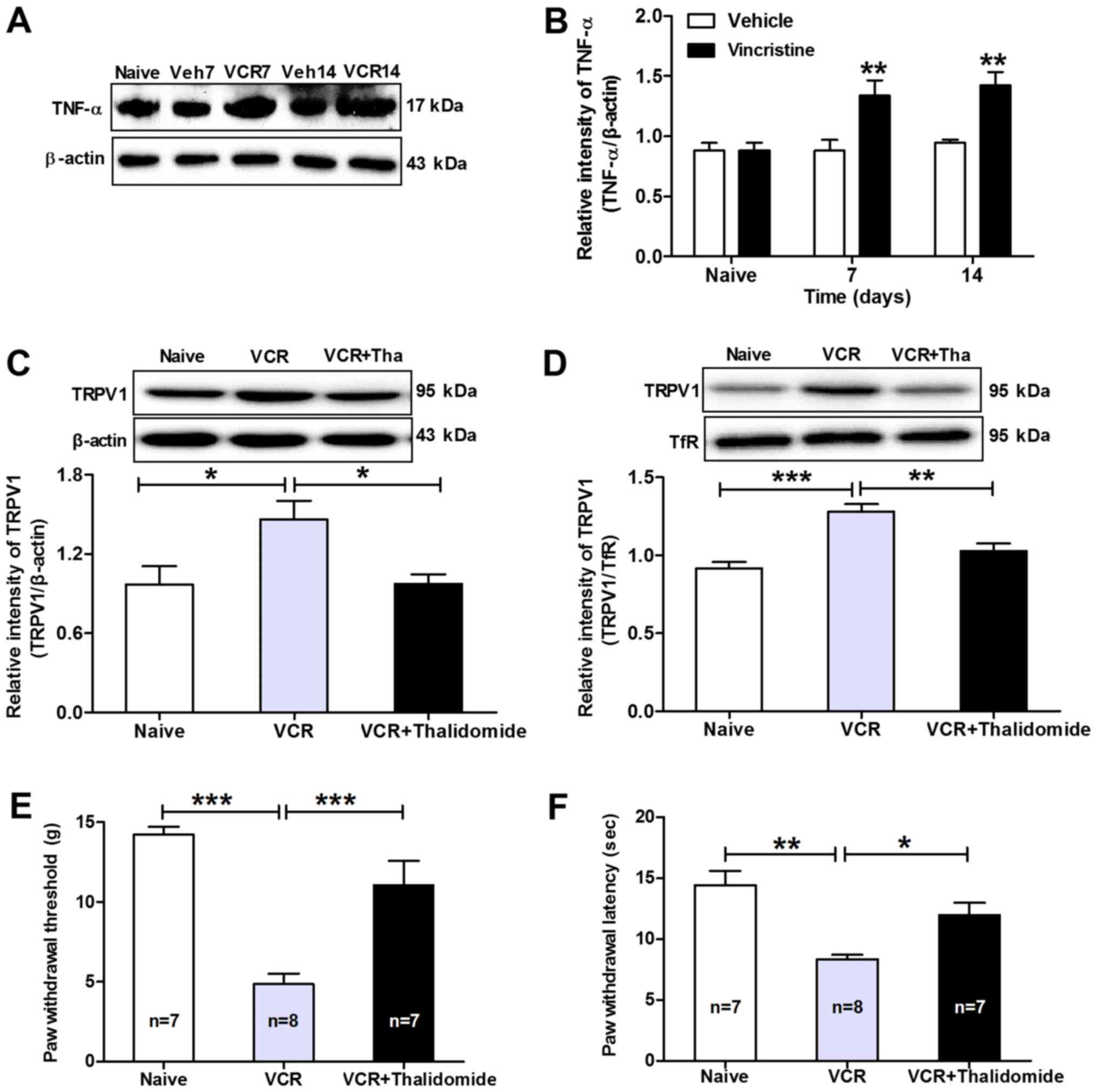|
1
|
Nieder C, Mehta MP and Jalali R: Combined
radio- and chemotherapy of brain tumours in adult patients. Clin
Oncol (R Coll Radiol). 21:515–524. 2009. View Article : Google Scholar : PubMed/NCBI
|
|
2
|
Raj TA, Smith AM and Moore AS: Vincristine
sulfate liposomal injection for acute lymphoblastic leukemia. Int J
Nanomedicine. 8:4361–4369. 2013.PubMed/NCBI
|
|
3
|
Eden T, Pieters R and Richards S;
Childhood Acute Lymphoblastic Leukaemia Collaborative Group
(CALLCG), : Systematic review of the addition of vincristine plus
steroid pulses in maintenance treatment for childhood acute
lymphoblastic leukaemia-an individual patient data meta-analysis
involving 5,659 children. Br J Haematol. 149:722–733. 2010.
View Article : Google Scholar : PubMed/NCBI
|
|
4
|
Quasthoff S and Hartung HP:
Chemotherapy-induced peripheral neuropathy. J Neurol. 249:9–17.
2002. View Article : Google Scholar : PubMed/NCBI
|
|
5
|
Sioka C and Kyritsis AP: Central and
peripheral nervous system toxicity of common chemotherapeutic
agents. Cancer Chemother Pharmacol. 63:761–767. 2009. View Article : Google Scholar : PubMed/NCBI
|
|
6
|
Hu C, Zhao YT, Zhang G and Xu MF:
Antinociceptive effects of fucoidan in rat models of
vincristine-induced neuropathic pain. Mol Med Rep. 15:975–980.
2017. View Article : Google Scholar : PubMed/NCBI
|
|
7
|
Allen DT and Kiernan JA: Permeation of
proteins from the blood into peripheral nerves and ganglia.
Neuroscience. 59:755–764. 1994. View Article : Google Scholar : PubMed/NCBI
|
|
8
|
Old EA, Nadkarni S, Grist J, Gentry C,
Bevan S, Kim KW, Mogg AJ, Perretti M and Malcangio M: Monocytes
expressing CX3CR1 orchestrate the development of
vincristine-induced pain. J Clin Invest. 124:2023–2036. 2014.
View Article : Google Scholar : PubMed/NCBI
|
|
9
|
Mitchell K, Bates BD, Keller JM, Lopez M,
Scholl L, Navarro J, Madian N, Haspel G, Nemenov MI and Iadarola
MJ: Ablation of rat TRPV1-expressing Adelta/C-fibers with
resiniferatoxin: Analysis of withdrawal behaviors, recovery of
function and molecular correlates. Mol Pain. 6:942010. View Article : Google Scholar : PubMed/NCBI
|
|
10
|
Han Q, Kim YH, Wang X, Liu D, Zhang ZJ,
Bey AL, Lay M, Chang W, Berta T, Zhang Y, et al: SHANK3 deficiency
impairs heat hyperalgesia and TRPV1 signaling in primary sensory
neurons. Neuron. 92:1279–1293. 2016. View Article : Google Scholar : PubMed/NCBI
|
|
11
|
Fang D, Kong LY, Cai J, Li S, Liu XD, Han
JS and Xing GG: Interleukin-6-mediated functional upregulation of
TRPV1 receptors in dorsal root ganglion neurons through the
activation of JAK/PI3K signaling pathway: Roles in the development
of bone cancer pain in a rat model. Pain. 156:1124–1144.
2015.PubMed/NCBI
|
|
12
|
Labuz D, Spahn V, Celik MÖ and Machelska
H: Opioids and TRPV1 in the peripheral control of neuropathic
pain-Defining a target site in the injured nerve.
Neuropharmacology. 101:330–340. 2016. View Article : Google Scholar : PubMed/NCBI
|
|
13
|
Morales-Lázaro SL, Llorente I,
Sierra-Ramírez F, López-Romero AE, Ortíz-Rentería M, Serrano-Flores
B, Simon SA, Islas LD and Rosenbaum T: Inhibition of TRPV1 channels
by a naturally occurring omega-9 fatty acid reduces pain and itch.
Nat Commun. 7:130922016. View Article : Google Scholar : PubMed/NCBI
|
|
14
|
Xiao X, Zhao XT, Xu LC, Yue LP, Liu FY,
Cai J, Liao FF, Kong JG, Xing GG, Yi M and Wan Y: Shp-1
dephosphorylates TRPV1 in dorsal root ganglion neurons and
alleviates CFA-induced inflammatory pain in rats. Pain.
156:597–608. 2015. View Article : Google Scholar : PubMed/NCBI
|
|
15
|
Xu Q, Zhang XM, Duan KZ, Gu XY, Han M, Liu
BL, Zhao ZQ and Zhang YQ: Peripheral TGF-β1 signaling is a critical
event in bone cancer-induced hyperalgesia in rodents. J Neurosci.
33:19099–19111. 2013. View Article : Google Scholar : PubMed/NCBI
|
|
16
|
Kiguchi N, Maeda T, Kobayashi Y, Saika F
and Kishioka S: Involvement of inflammatory mediators in
neuropathic pain caused by vincristine. Int Rev Neurobiol.
85:179–190. 2009. View Article : Google Scholar : PubMed/NCBI
|
|
17
|
Shen Y, Zhang ZJ, Zhu MD, Jiang BC, Yang T
and Gao YJ: Exogenous induction of HO-1 alleviates
vincristine-induced neuropathic pain by reducing spinal glial
activation in mice. Neurobiol Dis. 79:100–110. 2015. View Article : Google Scholar : PubMed/NCBI
|
|
18
|
Constantin CE, Mair N, Sailer CA,
Andratsch M, Xu ZZ, Blumer MJ, Scherbakov N, Davis JB, Bluethmann
H, Ji RR and Kress M: Endogenous tumor necrosis factor alpha
(TNFalpha) requires TNF receptor type 2 to generate heat
hyperalgesia in a mouse cancer model. J Neurosci. 28:5072–5081.
2008. View Article : Google Scholar : PubMed/NCBI
|
|
19
|
Rozas P, Lazcano P, Piña R, Cho A, Terse
A, Pertusa M, Madrid R, Gonzalez-Billault C, Kulkarni AB and
Utreras E: Targeted overexpression of tumor necrosis factor-α
increases cyclin-dependent kinase 5 activity and TRPV1-dependent
Ca2+ influx in trigeminal neurons. Pain. 157:1346–1362.
2016. View Article : Google Scholar : PubMed/NCBI
|
|
20
|
Kahng J, Kim TK, Chung EY, Kim YS and Moon
JY: The effect of thioctic acid on allodynia in a rat
vincristine-induced neuropathy model. J Int Med Res. 43:350–355.
2015. View Article : Google Scholar : PubMed/NCBI
|
|
21
|
Jiang H, Fang D, Kong LY, Jin ZR, Cai J,
Kang XJ, Wan Y and Xing GG: Sensitization of neurons in the central
nucleus of the amygdala via the decreased GABAergic inhibition
contributes to the development of neuropathic pain-related
anxiety-like behaviors in rats. Mol Brain. 7:722014. View Article : Google Scholar : PubMed/NCBI
|
|
22
|
Chaplan SR, Bach FW, Pogrel JW, Chung JM
and Yaksh TL: Quantitative assessment of tactile allodynia in the
rat paw. J Neurosci Methods. 53:55–63. 1994. View Article : Google Scholar : PubMed/NCBI
|
|
23
|
Tyrrell L, Renganathan M, Dib-Hajj SD and
Waxman SG: Glycosylation alters steady-state inactivation of sodium
channel Nav1.9/NaN in dorsal root ganglion neurons and is
developmentally regulated. J Neurosci. 21:9629–9637.
2001.PubMed/NCBI
|
|
24
|
Chen Y, Zhang Y, Huo Y, Wang D and Hong Y:
Adrenomedullin mediates tumor necrosis factor-α-induced responses
in dorsal root ganglia in rats. Brain Res. 1644:183–191. 2016.
View Article : Google Scholar : PubMed/NCBI
|
|
25
|
Xu J.E.X..Liu H, Li F, Cao Y, Tian J and
Yan J: Tumor necrosis factor-alpha is a potential diagnostic
biomarker for chronic neuropathic pain after spinal cord injury.
Neurosci Lett. 595:30–34. 2015. View Article : Google Scholar : PubMed/NCBI
|
|
26
|
Sisignano M, Baron R, Scholich K and
Geisslinger G: Mechanism-based treatment for chemotherapy-induced
peripheral neuropathic pain. Nat Rev Neurol. 10:694–707. 2014.
View Article : Google Scholar : PubMed/NCBI
|
|
27
|
Bosilkovska M, Ing Lorenzini K,
Uppugunduri CR, Desmeules J, Daali Y and Escher M: Severe
vincristine-induced neuropathic pain in a CYP3A5 nonexpressor with
reduced CYP3A4/5 activity: Case study. Clin Ther. 38:216–220. 2016.
View Article : Google Scholar : PubMed/NCBI
|
|
28
|
Gong SS, Li YX, Zhang MT, Du J, Ma PS, Yao
WX, Zhou R, Niu Y, Sun T and Yu JQ: Neuroprotective effect of
matrine in mouse model of vincristine-induced neuropathic pain.
Neurochem Res. 41:3147–3159. 2016. View Article : Google Scholar : PubMed/NCBI
|
|
29
|
Walters ET: Neuroinflammatory
contributions to pain after SCI: Roles for central glial mechanisms
and nociceptor-mediated host defense. Exp Neurol. 258:48–61. 2014.
View Article : Google Scholar : PubMed/NCBI
|
|
30
|
Kochukov MY: Tumor necrosis factor-alpha
(TNF-alpha) enhances functional thermal and chemical responses of
TRP cation channels in human synoviocytes. Mol Pain. 5:492009.
View Article : Google Scholar : PubMed/NCBI
|
|
31
|
Sacerdote P, Franchi S, Gerra G, Leccese
V, Panerai AE and Somaini L: Buprenorphine and methadone
maintenance treatment of heroin addicts preserves immune function.
Brain Behav Immun. 22:606–613. 2008. View Article : Google Scholar : PubMed/NCBI
|
|
32
|
Sasaki M, Hashimoto S, Sawa T and Amaya F:
Tumor necrosis factor-alpha induces expression of C/EBP-beta in
primary afferent neurons following nerve injury. Neuroscience.
279:1–9. 2014. View Article : Google Scholar : PubMed/NCBI
|
|
33
|
Liu J, Du J, Yang Y and Wang Y:
Phosphorylation of TRPV1 by cyclin-dependent kinase 5 promotes
TRPV1 surface localization, leading to inflammatory thermal
hyperalgesia. Exp Neurol. 273:253–262. 2015. View Article : Google Scholar : PubMed/NCBI
|
|
34
|
Hensellek S, Brell P, Schaible HG, Bräuer
R and Segond von Banchet G: The cytokine TNFalpha increases the
proportion of DRG neurones expressing the TRPV1 receptor via the
TNFR1 receptor and ERK activation. Mol Cell Neurosci. 36:381–391.
2007. View Article : Google Scholar : PubMed/NCBI
|













